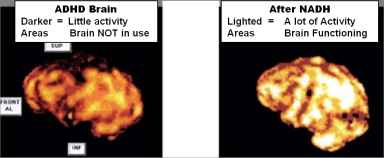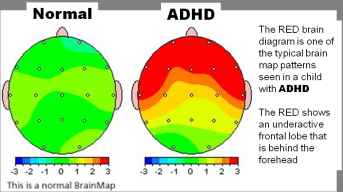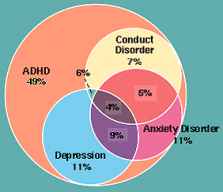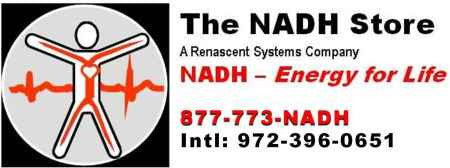ADD, ADHD Treatments with NADH increases brain health
 Summary: Great news, a clinical research study showed giving a person with ADHD a 20mg NADH daily dosage significantly increases their
Summary: Great news, a clinical research study showed giving a person with ADHD a 20mg NADH daily dosage significantly increases their  brain performance by up to 25% in the areas of the brain used for cognitive functioning (see the brain scan pictured on the right. The more lights in the area, the more the brain cells are functioning.). In an ADHD person, brain image scanning shows the brain's frontal lobe cells have less activity (a brain scan pictured on the far left) compared to a person without ADHD. NADH is a non stimulant, nutritional supplement that Mother Nature uses to increase brain cell activity in brain areas used for thinking, focusing, concentration, attention, memory recall, and decision making.
brain performance by up to 25% in the areas of the brain used for cognitive functioning (see the brain scan pictured on the right. The more lights in the area, the more the brain cells are functioning.). In an ADHD person, brain image scanning shows the brain's frontal lobe cells have less activity (a brain scan pictured on the far left) compared to a person without ADHD. NADH is a non stimulant, nutritional supplement that Mother Nature uses to increase brain cell activity in brain areas used for thinking, focusing, concentration, attention, memory recall, and decision making.
![]() Doctors recommend an ADHD patient take 20mg of NADH daily to experience the positive improvements of increased brain activity in the areas of cognitive functioning and relieve some ADHD symptoms. Depending on the type of ADHD, the ADHD symptom severity, and the length of time since their first diagnosis, it may take from a few days to few weeks to experience the positive effects of NADH. NADH has no side effects, and is safe to take with any other ADHD medication.
Doctors recommend an ADHD patient take 20mg of NADH daily to experience the positive improvements of increased brain activity in the areas of cognitive functioning and relieve some ADHD symptoms. Depending on the type of ADHD, the ADHD symptom severity, and the length of time since their first diagnosis, it may take from a few days to few weeks to experience the positive effects of NADH. NADH has no side effects, and is safe to take with any other ADHD medication.
Clinical Study Publication (click on the link to download):
NADH proves to be beneficial as an ADHD treatment
The Higher Level of NADH in the Blood - The Higher the ATP in the Cell
 Video Section:
Video Section:
NADH = Enadalert - ENADA
Famous Psychologist Dr Adrian Roell says
NADH's positive effects can be seen on brain scans [00:52]
The Full Text of "Depression - NADH a successful anti depressant"
(This Full Text section may repeat video(s) & clinical study publications found in the Summary)
Attention-Deficit / Hyperactivity Disorder or ADHD:
The Clinical Testing:
 Great news, a clinical study showed that an person with ADHD taking 20mg of NADH (daily) had a 25% increase in brain activity within the areas of the brain used for cognitive functioning. Other research studies have shown a person with ADHD have a deficit in specific vitamins and nutrients. This ADHD clinical research study was started to test the effects of a NADH supplement on a person with ADHD. The ADHD clinical testing results show giving a person with ADHD 20mg of NADH (daily) will increase their brain performance by up to 25% in the areas of the brain used for cognitive functioning. Brain scan imaging has shown NADH produces cognitive brain activity in the frontal lobes of the brain. In an ADHD person, brain image scanning shows this frontal lobe area of the brain has less activity when compared to a "normal person," specifically a person without ADHD. What is great news is NADH is a non stimulant, nutritional supplement that is from nature itself. NADH is already found in every cell within the body. The NADH nutrition comes from a person's diet. Mother Nature uses NADH to increase brain activity in the areas of the brain used in thinking, focusing, concentration, attention, memory recall, and decision making.
Great news, a clinical study showed that an person with ADHD taking 20mg of NADH (daily) had a 25% increase in brain activity within the areas of the brain used for cognitive functioning. Other research studies have shown a person with ADHD have a deficit in specific vitamins and nutrients. This ADHD clinical research study was started to test the effects of a NADH supplement on a person with ADHD. The ADHD clinical testing results show giving a person with ADHD 20mg of NADH (daily) will increase their brain performance by up to 25% in the areas of the brain used for cognitive functioning. Brain scan imaging has shown NADH produces cognitive brain activity in the frontal lobes of the brain. In an ADHD person, brain image scanning shows this frontal lobe area of the brain has less activity when compared to a "normal person," specifically a person without ADHD. What is great news is NADH is a non stimulant, nutritional supplement that is from nature itself. NADH is already found in every cell within the body. The NADH nutrition comes from a person's diet. Mother Nature uses NADH to increase brain activity in the areas of the brain used in thinking, focusing, concentration, attention, memory recall, and decision making.
The current recommendation states an ADHD patient should take 20mg of NADH daily to experience the positive improvements of increased brain activity in the areas of cognitive functioning and relieve some of ADHD symptoms. Depending on the type of ADHD, the ADHD symptom severity, and the length of time since their first diagnosis, it may take from a few days to several weeks to experience the positive effects of NADH. NADH has no side effects, and is safe to take with other ADHD medications. Brain image scanning shows giving NADH to a person with ADHD increases frontal lobe brain activity. These frontal lobe cells of the brain are very important in providing energy used for thinking, focusing, concentration, attention, memory recall, and decision making.
NADH: A Background
 The NADH ADHD treatment comes from a co-enzyme called NADH or nicotinamide adenine dinucleotide with the ‘H’ standing for hydrogen. What makes NADH promising to treat ADHD is Mother Nature uses NADH to create ATP energy in brain cells. Also NADH stimulates the production of necessary brain chemicals called neurotransmitters for healthy brain functioning. The creation of ATP energy takes place in a process called "cellular respiration." Cellular respiration is not breathing. Cellular respiration is like a cellular engine. Like a car engine that brings both fuel and air together to create power. A cellular engine is used to create (ATP) power for all living things. ATP powers the brain for thought, memory, attention, focus, concentration, decision making, and more; in the muscles ATP powers muscle movements, running, jumping, balance, co-ordination, heart beats, breathing air, etc.. Within the cellular respiration engine, all human cells bring glucose (the fuel) and oxygen (the air) together, and with the spark of NADH (the spark plug) ATP is created. ATP is used to power all living things. Clinical testing has proven the more NADH a cell has, the more ATP power the cell produces. A NADH nutritional supplement can of resupply brain cells with ATP energy. For more information about how Mother Nature uses NADH to create ATP, see this website's section called The Guided Tour.
The NADH ADHD treatment comes from a co-enzyme called NADH or nicotinamide adenine dinucleotide with the ‘H’ standing for hydrogen. What makes NADH promising to treat ADHD is Mother Nature uses NADH to create ATP energy in brain cells. Also NADH stimulates the production of necessary brain chemicals called neurotransmitters for healthy brain functioning. The creation of ATP energy takes place in a process called "cellular respiration." Cellular respiration is not breathing. Cellular respiration is like a cellular engine. Like a car engine that brings both fuel and air together to create power. A cellular engine is used to create (ATP) power for all living things. ATP powers the brain for thought, memory, attention, focus, concentration, decision making, and more; in the muscles ATP powers muscle movements, running, jumping, balance, co-ordination, heart beats, breathing air, etc.. Within the cellular respiration engine, all human cells bring glucose (the fuel) and oxygen (the air) together, and with the spark of NADH (the spark plug) ATP is created. ATP is used to power all living things. Clinical testing has proven the more NADH a cell has, the more ATP power the cell produces. A NADH nutritional supplement can of resupply brain cells with ATP energy. For more information about how Mother Nature uses NADH to create ATP, see this website's section called The Guided Tour.
Doctors that have tested NADH on patients have stated:
- NADH is a safe, natural compound that has shown much promise with patients in Europe
- Much more extensive research and testing is needed
- The clinical trials for the treatment of ADHD patients is a significant step, down a long road to investigate the many potential benefits of this natural co-enzyme called NADH.
NADH is a co-enzyme. The American Heritage Dictionary defines a co-enzyme as:
- a non-protein organic substance that usually contains a vitamin or mineral and combines with a specific protein, to form an active enzyme system
NADH is not a drug, not a stimulant, and is non-toxic even in very large dosages. NADH was tested for 26 weeks at 1,000mg daily and was found not to have any negative side effects. NADH is already found within every human cell. Because it is already in every human cell, NADH can safely be taken with any other medication. After extensive safety testing, it was proven NADH does not have any negative side effects and no adverse drug interactions. See this website’s section called Safety First for more information.
The most important thing to remember about the NADH is that it is found within every human cell, and:
- NADH increases the levels of ATP cellular energy. The more NADH cells have, the more ATP energy cells produce. NADH increases cell longevity.
- NADH is a powerful antioxidant, and scavenger of free radicals. According to Dr. Passwater, "NADH may just be the most powerful antioxidant"
- NADH is the active ingredient in cellular DNA repair. NADH plays an active role in the repair of damaged tissue.
- NADH stimulates the immune system
- NADH enhances the production of dopamine, a very important brain chemical (also known as a neurotransmitter)
- NADH increases the bio-availability of nitric oxide, known to provide increased blood flow, oxygen delivery, glucose uptake, muscle velocity, power output, and muscle growth
Attention-Deficit / Hyperactivity Disorder or ADHD: The ILLINESS
Attention-deficit / hyperactivity disorder (ADHD) is a mental health condition. The symptoms of ADHD include inattention, hyperactivity and impulsivity. These are characteristics that most children will display at some point during their childhood. To establish a diagnosis of ADHD, the symptoms should be inappropriate for the child's age or have a negative impact on the child's ability to function. Adults can have ADHD. Every 2 out of 3 kids with ADHD continue to have symptoms when they are adults. When adults have ADHD, the symptoms may change. For example, an adult with ADHD may experience restlessness instead of hyperactivity. In some cases, adults with ADHD often have problems with employment and/or interpersonal relationships.
There are three different types of ADHD:
- Combined ADHD (the most common type), which involves symptoms of inattentiveness, hyperactivity or impulsiveness
- Inattentive ADHD (also known as ADD), which means impaired attention and concentration
- Hyperactive-impulsive ADHD, which is hyperactivity without inattentiveness
ADHD has three symptom categories:
- Inattention
- Hyperactivity
- Impulsivity
- Difficulty paying attention to details and tendency to make careless mistakes
- Producing work that is often messy and careless
- Easily distracted by something irrelevant
- Frequently interrupting ongoing tasks to attend to trivial noises that are usually ignored by others
- Inability to sustain attention on tasks or activities
- Difficulty finishing schoolwork or paperwork or performing tasks that require concentration
- Frequent shifts from one uncompleted activity to another
- Procrastination
- Disorganized work habits
- Forgetfulness in daily activities (for example, missing appointments, forgetting to bring lunch)
- Failure to complete tasks such as homework or chores
- Frequent shifts in conversation, not listening to others, not keeping one's mind on conversations, and not following details or rules of activities in social situations
- Fidgeting, squirming when seated
- Getting up frequently to walk or run around
- Running or climbing excessively when it's inappropriate (in teens this may appear as restlessness)
- Having difficulty playing quietly or engaging in quiet leisure activities
- Always being 'on the go'
- Often talking excessively
Impulsivity: Children with "impulsivity" symptoms engage in potentially dangerous activities without considering the consequences. (For example: they may climb to extreme heights or get themselves into dangerous places.) It is true, many of these symptoms occur from time to time in normal children. However, in ADHD children they occur frequently at home, at school or when visiting with a friend. ADHD is diagnosed only when a child consistently displays some or all of these behaviors in at least two settings (such as at home and at school) for at least six months. These impulsivity behaviors include:
- Impatience
- Difficulty delaying responses
- Blurting out answers before questions have been completed
- Difficulty awaiting one's turn
- Frequently interrupting or intruding others, where the interruption causes problems in social settings or at work
- Initiating conversations at inappropriate times
Almost everyone has some symptoms similar to ADHD at some time in their lives. If the person’s difficulties occur only occasionally, the person probably doesn't have ADHD. ADHD is diagnosed only when symptoms are severe enough to cause ongoing problems in more than one area of the person's life. These persistent and disruptive symptoms can be traced back to early childhood.
- a blood relative (parent or sibling) has ADHD
- the mother smoked, drank alcohol or used drugs during pregnancy
- the mother was exposed to environmental poisons or toxins (like polychlorinated biphenyls or PCBs) during pregnancy
- as a child, the child was exposed to environmental toxins (like lead found in old paint or the pipes of old buildings)
- the child was born prematurely
- Difficulty following instructions
- Being unable to get organized, either at home, work or school
- Fidgeting, especially with the hands and feet
- Talking too much
- Failing to finish projects, including chores and homework
- Not paying attention to details
- Getting poor grades in school
- Being isolated from peers due to poor grades and secondary depression
 If inattention, hyperactivity or impulsive behavior continually disrupts a person’s life, have them talk to a qualified health care professional about whether they might have ADHD. The signs of ADHD are similar to those of a number of other health conditions. In some cases, the person may not have ADHD. They may have another condition that needs treatment. When seeking an evaluation / diagnosis or treatment for ADHD, it is important to see a qualified health care professional who has experience in dealing with this disorder. There are several types of professionals who typically diagnose ADHD. These include doctors (especially psychiatrists, pediatricians, internists, and family physicians), psychologists (including school psychologists), social workers, nurse practitioners, physician assistants, and other licensed therapists (for example, professional counselors and family therapists).
If inattention, hyperactivity or impulsive behavior continually disrupts a person’s life, have them talk to a qualified health care professional about whether they might have ADHD. The signs of ADHD are similar to those of a number of other health conditions. In some cases, the person may not have ADHD. They may have another condition that needs treatment. When seeking an evaluation / diagnosis or treatment for ADHD, it is important to see a qualified health care professional who has experience in dealing with this disorder. There are several types of professionals who typically diagnose ADHD. These include doctors (especially psychiatrists, pediatricians, internists, and family physicians), psychologists (including school psychologists), social workers, nurse practitioners, physician assistants, and other licensed therapists (for example, professional counselors and family therapists).- Interviews with the parents, relatives, teachers, or other adults
- Personally watching the child, teen or adult
- Questionnaires or rating scales that measure ADHD symptoms
- Psychological tests
- The Vanderbilt Assessment Scale: A 55-question assessment test that reviews ADHD symptoms. This assessment also looks for other conditions such as conduct disorder, oppositional-defiant disorder, anxiety, and depression.
- Behavior Assessment System for Children (BASC): This test looks for things like hyperactivity, aggression, and conduct problems. This test also looks for anxiety, depression, attention and learning problems, and lack of certain essential skills.
- Child Behavior Checklist/Teacher Report Form (CBCL): Among other things, this scale looks at physical complaints, aggressive or delinquent behavior, and withdrawal.
- The treatments include: stimulant medications, non-stimulant medications, other ADHD drugs to control unwanted side effects, an ADHD medication chart (for a side-by-side comparison of the various types of ADHD medications used and their most common side effects), talking to a therapist and much more.
- ADHD Home Remedies include: vitamins and supplements (like Zinc, St. John’s Wort, prescription-strength omega-3, primrose oil to name a few), an ADHD diet, exercise, and learning what a person can do to better cope with anxiety and stress.
- The NADH Store is teaching NADH is a successful at treating certain types of ADHD
Conclusion:
The current recommendation states, an ADHD patient should take 20mg of NADH daily to experience the positive improvements of increased brain activity in the areas of cognitive functioning. Depending on the type of ADHD, the ADHD symptom severity, and the length of time since their first diagnosis, it may take from a few days to few weeks to experience the positive effects of NADH. NADH has no side effects, and is safe to take with any other ADHD medication.
NADH is already found within all human cells. The more NADH the cell has, the more ATP energy the cell produce. ATP energy enables the brain cells to provide: thinking, memory, concentration, decision making, mental clarity, etc. See this website’s section called ATP Energy for more information. NADH stimulates the immune system used to fight diseases, and most importantly NADH enhances the production of the brain chemical called dopamine. Clinical testing proves sufficient levels of dopamine are required for normal brain functions.
The brain cell need high levels of NADH. If the cell's NADH levels are depleted, the brain will no longer function properly. It is NOT known how NADH becomes depleted from the body. Today, a scientific breakthrough has enabled NADH to be manufactured in a stabilized form. A person can restore their NADH levels by taking a NADH nutritional supplement. The same NADH nutritional supplement used in the ADHD clinical study is available from this website or other high quality nutritional supplement stores. Use ONLY the stabilized form of NADH (See this website's section called Let the Buyer Beware) A high quality FDA licensed laboratory environment is used to manufacture the NADH available from this website; it ensures that each and every tablet or lozenge is of the highest, professional grade standard.
Take a copy of the clinical study to the patient's doctor or healthcare professional and discuss the options. The clinical study is yours to take. The ADHD clinical testing results show giving a child with ADHD 20mg of NADH daily will increase their brain performance by up to 25% in the areas of the brain used for cognitive functioning. Science has proven that these areas of the brain are used in thinking, focusing, concentration, attention, memory recall, and decision making. Always check with your doctor before taking any nutritional supplement, but we recommend that you try NADH for 30 days to relieve some ADHD symptoms. If the results are not evident, we (The NADH Store) will refund your money (less shipping and handling), no questions asked. Order NADH today. You will be glad you did!
Publications (click on the link to download):

NADH proves to be beneficial as an ADHD treatment
The Higher Level of NADH in the Blood - The Higher the ATP in the Cell
 Video Section:
Video Section:
NADH = Enadalert = ENADA
Oz Garcia Famous Nutritionist to the Stars says
NADH is great for cognitive performance improvements [01:13]
Famous Psychologist Dr Adrian Roell says
NADH's positive effects can be seen on brain scans [00:52]


